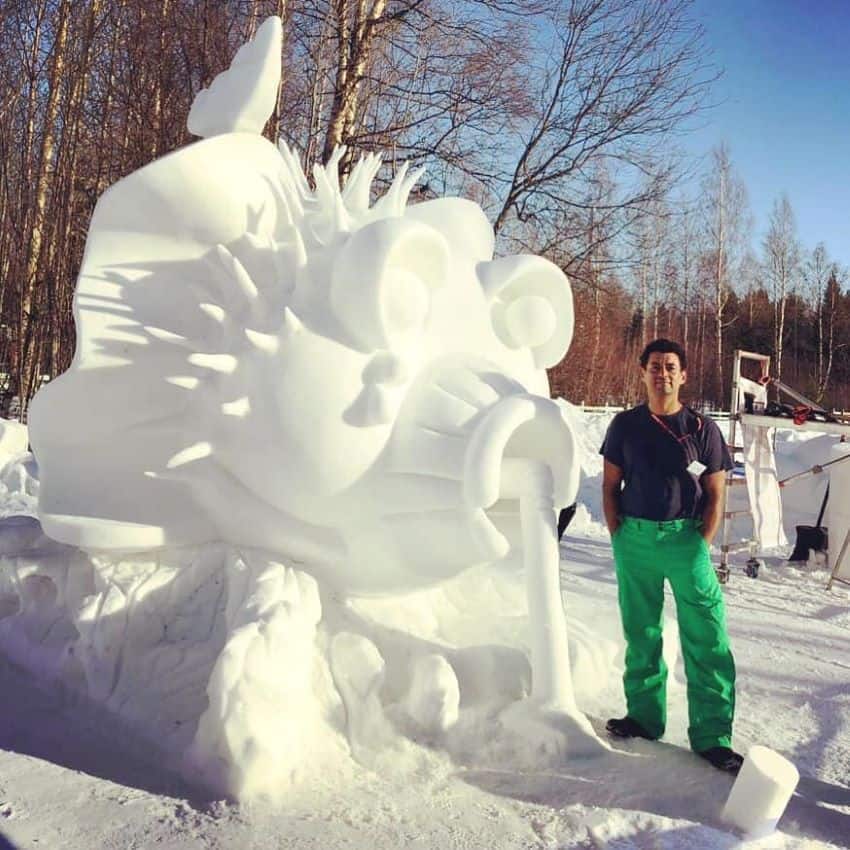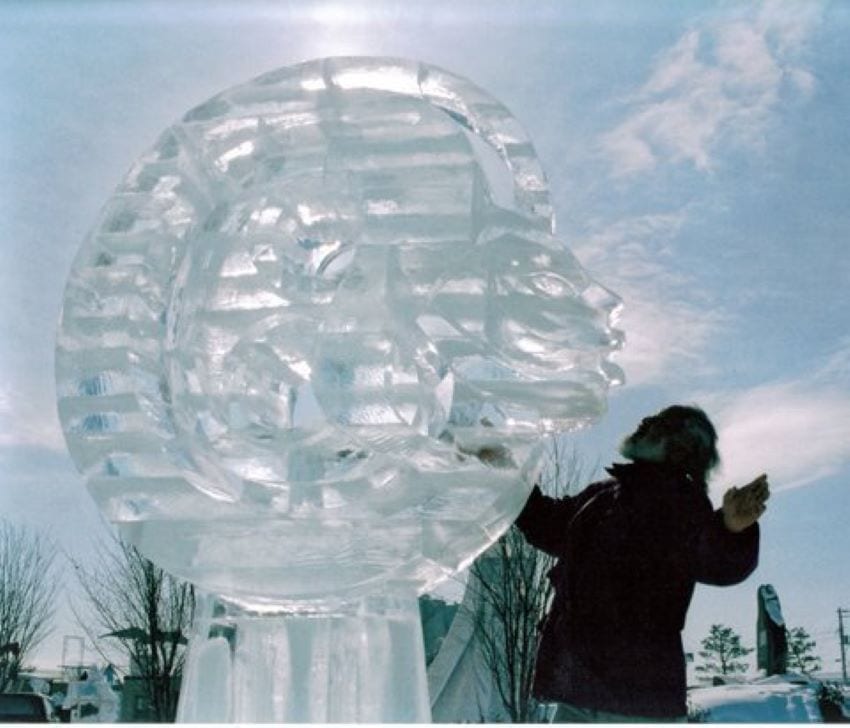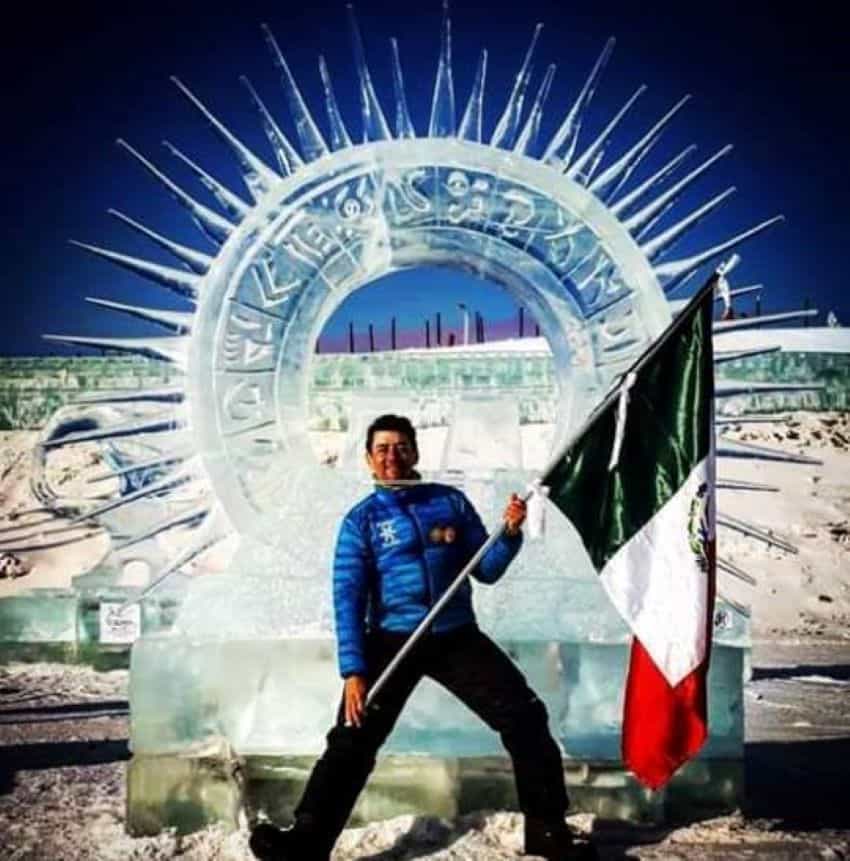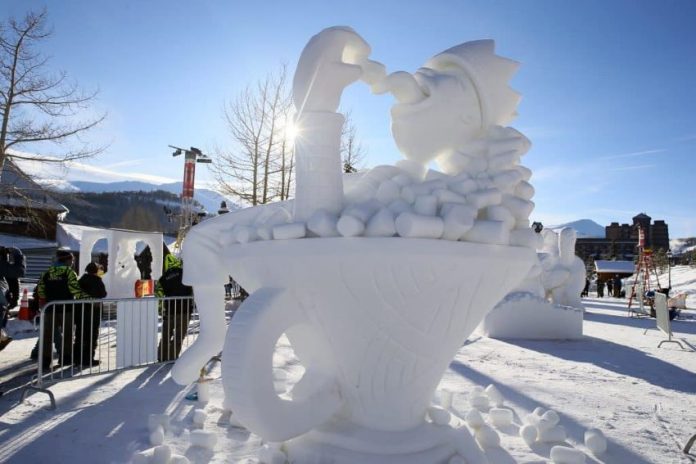Most foreigners flee to Mexico to escape the ice and snow, but some Mexicans actually go looking for it.
Born in 1943 in Mexico City, internationally recognized snow and ice sculpture sculptor Abel Ramírez Aguilar only began competing in the sport in the 1980s, after encountering snow for the first time in his 40s. Visiting friends in Quebec, his first experience of snow was magical and sensual.
But snow did not make him a sculptor. He already had a long and distinguished sculpting career working bronze, stone and wood as well as teaching at the prestigious La Esmeralda art school in Mexico City. His challenge with this new pastime was to learn how to apply his skills to two media not available in large quantities in his home country — snow and ice.
His apprenticeship began when he participated in events in Quebec as an amateur, attracting attention almost immediately. He also impressed his Canadian friends: without his knowledge, they registered him to compete in a snow-and-ice sculpting competition held in conjunction with the 1992 Olympic Winter Games in France.
Much to his surprise, and to the delight of his students at La Esmeralda, his entry won a gold medal and more invitations to compete. This was the start of a 20-year career competing in ice and snow sculpture in various parts of North America, Europe and Asia.

Monumental ice and snow sculptures are not created by one person but rather teams. From almost the beginning, Ramírez Aguilar captained groups, inviting other Mexicans to join him. Although he has trained many like him, to date it has not resulted in any kind of formal or informal organization of Mexican ice and snow sculptors. He retired from the sport in the 2000s, although he is still an active sculptor in more traditional media.
Ice and snow sculptors here still get started much the same way that Ramírez Aguilar did: a casual connection introduces them to the world of monumental snow and ice art and they get hooked. Today, one of the most notable competitive sculptors in Mexico is Carlos Miguel Ramírez Pereyra, who is from the “city of the palms,” tropical Colima.
He, too, fell into it by accident, invited by another competitive sculptor who needed a last-minute fourth member for a team going to a Breckenridge, Colorado, event in 2008. He is not an artist; his training is in computer science, and he was studying for a second degree in architecture when he received the call to compete.
To date, Ramírez Pereyra has worked with 74 others to create 33 monumental pieces in 16 countries. He attends up to four competitions each year, inviting friends and others with sculpting abilities to join him on his “cold adventures.” He was part of the Mexican teams that won Breckenridge both in 2019 and 2020. He has even gone on to work in competitions in sand, hay and corn — materials that are in much greater supply in Mexico.
Competing is not easy, and artists consider participation more of an adventure than a serious professional activity. Ramírez Pereyra’s family thinks he is a little crazy to be so dedicated to this. Although accepted teams generally receive financial support for their participation, that may cover no more than 70% of travel costs. In addition, there is the need for cold-weather clothing not available in Mexico — special boots designed for temperatures of -40 C, for example. Participants often need to save money to afford the costs of competing, and this requirement alone is enough to limit many who might otherwise represent Mexico more often.
Despite that, Mexican artists have acquitted themselves admirably all over the world.

The annual competition in Breckenridge still sparks the most interest from south of the border. At least one team from Mexico has competed there every year for at least 15 years. Mexican teams have placed first on multiple occasions: a Mexican team won the gold medal here in both 2020 and 2019.
It is where Ramírez Pereyra and Ramírez Aguilar met, one at the beginning of his competitive career and one near the end.
Ramírez Pereyra says that the reception Mexican sculptures receive all over the world is still amazing. People continue to be surprised to see Mexicans in these competitions at all since the country is so associated with sun and beaches. They ask, “How do you practice?” — to which Ramírez Pereyra says that he cannot, which makes his and other sculptors’ success in this field even more impressive.
Mexican ice and snow sculptors have a strong tendency to work in themes related to their nationality, history and ethnicity, particularly pre-Hispanic gods and symbols or national symbols such as the Mexican flag. They also use images from folk art such as alebrijes. Ramírez Aguilar says that since such sculptures are displayed in an international setting, nationalist themes are the most appropriate. It also helps that such symbols allow for Mexican artists’ work to stand out among the competition rather than try and copy what other artists do.
However, there is also some indication that these artists are branching out: the Mexican team at Breckenridge in 2020 — which took the gold — was titled Greed; it was an image of a fat king eating while sitting on a pile of food.
Rob Neyland, the founder of the Breckenridge International Snow Sculptures Championships, calls the Mexican participants “one of the darlings of this international competition.”

“When [the Mexicans] first attended years ago, coming from a country without snow, their sculptures were clumsy but inspired,” he said. “They took notes — studying the tools and techniques they saw. They brought a whimsical humor, humility, passion and the pursuit of excellence.”
“Before you knew it,” he adds, “they were showing up and kicking ass!”
Leigh Thelmadatter arrived in Mexico 17 years ago and fell in love with the land and the culture. She publishes a blog called Creative Hands of Mexico and her first book, Mexican Cartonería: Paper, Paste and Fiesta, was published last year. Her culture blog appears regularly on Mexico News Daily.
